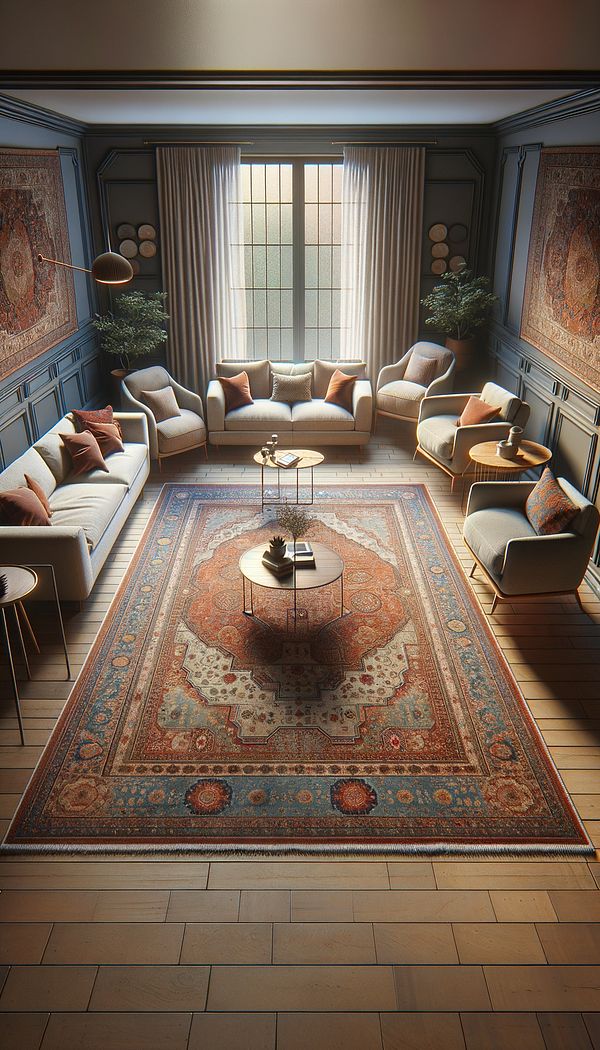What is an Oriental Rug?
An Oriental rug is a heavy textile made for a wide variety of utilitarian and symbolic purposes in countries of the Oriental region.
Description
An Oriental rug reflects a piece of history and art from the Orient, broadly encompassing Asian countries like Persia (now Iran), Turkey, India, and China, among others. These rugs are characterized by their intricate designs, rich colors, and unique weaving techniques, making each piece a work of art. Traditionally, these rugs were handwoven, which adds to their value and distinctiveness. The motifs and patterns often found in Oriental rugs include floral designs, geometric shapes, and pictorial scenes, each carrying its own cultural significance and story.
The process of creating an Oriental rug is labor-intensive and involves a high level of craftsmanship. Depending on the rug’s size, design complexity, and weaving technique, making a single rug can take anywhere from a few months to several years. The materials most commonly used in their production include wool, cotton, and silk, contributing to the rug's durability, texture, and appearance. Oriental rugs are not only sought after for their aesthetic appeal but also for their quality and longevity, making them a valuable investment for many homeowners and collectors.
In contemporary interior design, Oriental rugs serve as a focal point in a room, adding warmth, character, and a touch of exotic elegance. These rugs can complement a wide range of decorating styles, from traditional to modern, and can be used in various settings, including living rooms, bedrooms, and offices. The rich patterns and colors of Oriental rugs make them versatile decorative elements that enhance the overall ambiance of a space.
Usage
Oriental rugs can be found enhancing the decor of various living spaces, from traditional homes to contemporary offices. They often occupy central areas like living rooms, dining rooms, or underneath furniture, where they add warmth, texture, and a splash of color. Interior designers appreciate Oriental rugs for their ability to tie disparate elements of a room together, making them a popular choice for adding depth and interest to interior spaces.
FAQs
-
How do I identify an authentic Oriental rug?
An authentic Oriental rug is handmade, featuring intricate designs and a high knot count. Look for natural materials like wool, silk, or cotton, and check the rug's underside for evenness of knots and the signature of the weaver, if available. Authentic rugs often have slight imperfections due to their handmade nature.
-
How do I care for my Oriental rug?
To care for an Oriental rug, vacuum gently without a beater bar, avoid direct sunlight to prevent fading, rotate periodically to wear evenly, and clean spills immediately with a dry cloth. Professional cleaning is recommended every few years, depending on foot traffic.
-
Can Oriental rugs be used in modern interior design?
Absolutely! Oriental rugs can complement modern interior design by adding warmth, texture, and a touch of timeless elegance. Their rich patterns and colors can serve as a focal point or as a way to tie together various design elements within a contemporary setting.
Practical Application
When incorporating an Oriental rug into your interior design, consider the color scheme and the overall style of the room. Choose a rug that complements your existing decor but also stands out as a statement piece. Ensure the rug size is appropriate for the area you wish to cover, creating harmony and balance in the space. To protect your investment, place a rug pad underneath to prevent slipping and extend the rug’s life.
-
Decorating Principles & Elements330 articles
-
Color & Patterns154 articles
-
Textiles & Upholstery252 articles
-
Flooring & Carpets48 articles
-
Scatter-Back SofaA scatter-back sofa is a style of sofa characterized by multiple loose cushions arranged across its back.
-
CoverletA coverlet is a lightweight, decorative bedspread.
-
CamelbackA camelback is a high, rising curve on a piece of furniture that resembles the shape of a camel's hump.
-
ColorfastColorfastness refers to the resistance of a material's color to fading or running.
-
Queen AnneAn architectural and furniture design style that originated in the late 17th and early 18th centuries, characterized by its elegant and ornate features.
